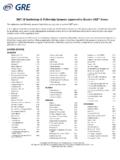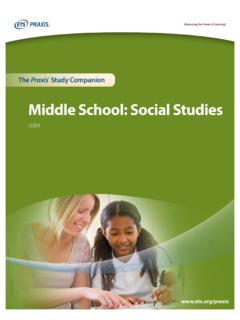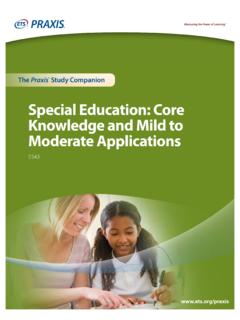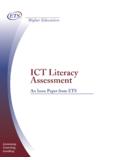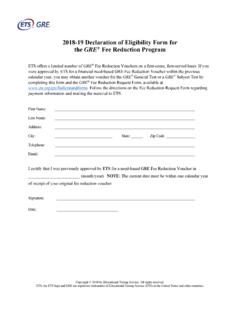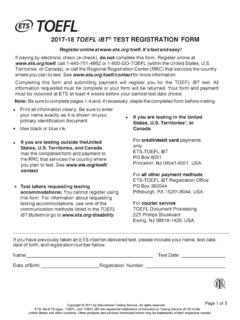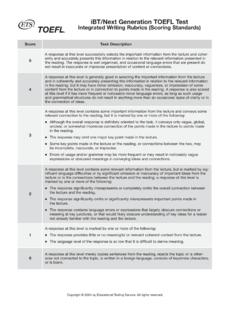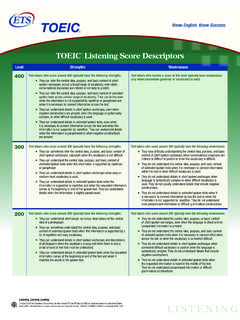Transcription of Spanish: World Language Study Companion
1 Spanish: World Language Praxis Study CompanionThe Praxis Study Companion2 Welcome to the Praxis Study CompanionWelcome to The Praxis Study Companion Prepare to Show What You KnowYou have been working to acquire the knowledge and skills you need for your teaching career. Now you are ready to demonstrate your abilities by taking a Praxis test. Using the Praxis Study Companion is a smart way to prepare for the test so you can do your best on test day. This guide can help keep you on track and make the most efficient use of your Study Study Companion contains practical information and helpful tools, including: An overview of the Praxis tests Specific information on the Praxis test you are taking A template Study plan Study topics Practice questions and explanations of correct answers Test-taking tips and strategies Frequently asked questions Links to more detailed informationSo where should you start? Begin by reviewing this guide in its entirety and note those sections that you need to revisit.
2 Then you can create your own personalized Study plan and schedule based on your individual needs and how much time you have before test in mind that Study habits are individual. There are many different ways to successfully prepare for your test. Some people Study better on their own, while others prefer a group dynamic. You may have more energy early in the day, but another test taker may concentrate better in the evening. So use this guide to develop the approach that works best for teaching career begins with preparation. Good luck!Know What to ExpectWhich tests should I take? Each state or agency that uses the Praxis tests sets its own requirements for which test or tests you must take for the teaching area you wish to you register for a test, confirm your state or agency s testing requirements at are the Praxis tests given?Praxis tests are given on computer. Other formats are available for test takers approved for accommodations (see page 62).
3 The Praxis Study Companion3 Welcome to the Praxis Study CompanionWhat should I expect when taking the test on computer?When taking the test on computer, you can expect to be asked to provide proper identification at the test center. Once admitted, you will be given the opportunity to learn how the computer interface works (how to answer questions, how to skip questions, how to go back to questions you skipped, etc.) before the testing time begins. Watch the What to Expect on Test Day video to see what the experience is and when are the Praxis tests offered?You can select the test center that is most convenient for you. The Praxis tests are administered through an international network of test centers, which includes Prometric Testing Centers, some universities, and other locations throughout the schedules may differ, so see the Praxis web site for more detailed test registration information at The Praxis Study Companion4 Table of ContentsTable of ContentsThe Praxis Study Companion guides you through the steps to success1.
4 Learn About Your Test ..5 Learn about the specific test you will be taking2. Familiarize Yourself with Test Questions ..11 Become comfortable with the types of questions you ll find on the Praxis tests3. Practice with Sample Test Questions ..15 Answer practice questions and find explanations for correct answers4. Determine Your Strategy for Success ..48 Set clear goals and deadlines so your test preparation is focused and efficient5. Develop Your Study Plan ..51 Develop a personalized Study plan and schedule6. Review Study Topics ..55 Review Study topics with questions for discussion7. Review Smart Tips for Success ..60 Follow test-taking tips developed by experts8. Check on Testing Accommodations ..62 See if you qualify for accommodations to take the Praxis test9. Do Your Best on Test Day ..63 Get ready for test day so you will be calm and confident10. Understand Your Scores ..65 Understand how tests are scored and how to interpret your test scoresAppendix: Other Questions You May Have.
5 67 The Praxis Study Companion5 Step 1: Learn About Your Test1. Learn About Your TestLearn about the specific test you will be takingSpanish: World Language (5195)Test at a GlanceTest Name Spanish: World LanguageTest Code 5195 Time Approximately 3 hours, including the Listening with Cultural Knowledge Practice and the optional Writing Practice with the built-in character toolbar for the Writing sectionNumber of Questions 75 selected-response questions and 6 constructed-response questionsFormat Listening with Cultural Knowledge Practice (not scored); 6 selected-response questions (10 minutes) Section 1. Listening with Cultural Knowledge; 36 selected-response questions (50 minutes) Section 2. Reading with Cultural Knowledge; 39 selected-response questions (50 minutes) Writing Practice (not scored); one optional practice constructed-response exercise using the built-in character toolbar (5 minutes) Section 3. Writing, with 3 constructed-response tasks (50 minutes) Section 4.
6 Speaking, with 3 constructed-response tasks (15 minutes)Test Delivery Computer delivered Approximate Approximate Content Categories Number of Percentage of Questions Examination I. Interpretive Listening, 30 selected response 26% including embedded linguistic content II. Interpretive Reading, 30 selected response 26% including embedded linguistic content III. Cultural Knowledge 15 selected response 12% (Tested in Sections 1 and 2) IV. Interpersonal and Presentational 3 written responses 18% Writing (constructed response) V. Presentational and Interpersonal 3 spoken responses 18% Speaking (constructed response)VIVIIIIIIThe Praxis Study Companion6 Step 1: Learn About Your TestAbout This TestThis test is designed to measure the knowledge, skills, and abilities of examinees who have had preparation in a program for teaching Spanish in grades K 12. Because programs in teaching Spanish are offered at both the undergraduate and graduate levels, this test is appropriate for examinees at either level.
7 All sections of this test are at the Advanced-Low level, as described in the proficiency guidelines of the American Council on the Teaching of Foreign Languages (ACTFL). This test integrates listening, reading, writing, and speaking skills, as well as linguistic and cultural knowledge, through active participation in a variety of questions in the interpretive modes (in the Listening and Reading sections) and in the interpersonal and presentational modes (in the Writing and Speaking sections). The Listening and Reading sections of the test are composed of selected-response questions, whereas the Writing and Speaking sections are composed of constructed-response tasks. All questions and answer choices are in Spanish and are based on various genres of authentic material, whether written or in audio format, from various Spanish-speaking regions of the World . This is a computer-based test with sections of various lengths and time constraints. All sections of the test are separately timed.
8 While the time allotted in the Reading and Writing sections is managed by the candidate, timing is computer controlled throughout the Listening and Speaking sections. Prior to beginning the Listening section, the candidate will participate in a practice exercise reflecting the type of questions in the Listening section. Similarly, there is a writing practice exercise prior to the Writing section to acquaint candidates with a special character toolbar that they will be using to type their individual responses in Spanish. This test may contain some questions that do not count toward your SpecificationsTest specifications in this chapter describe the knowledge and skills measured by the test. Study topics to help you prepare to answer test questions can be found on page Content Categories I, II, IV, and V Language , Linguistics, and Comparisons (88%)A. Demonstrating Language proficiency in the target Language (at the Advanced Low level, as described in the American Council on the Teaching of Foreign Languages [ACTFL] Proficiency Guidelines)The beginning Spanish teacher:1.
9 Knows how to communicate in the target Language with native speakers unaccustomed to interacting with nonnative speakers, with sufficient accuracy, clarity, and precision to convey the intended message2. Knows how to communicate in the interpersonal mode (speaking) by participating actively in informal and formal conversations on topics covering home, school, leisure activities, and current events3. Knows how to communicate in the interpersonal mode (writing) in written exchanges on daily topics4. Comprehends in the interpretive mode (listening) main ideas and supporting details of audio segments, such as news items, short stories, social notices, and reports on familiar topics that deal with factual information5. Comprehends in the interpretive mode (reading) main ideas and supporting details of printed texts, such as news items, short stories, social notices, and reports on familiar topics that deal with factual information6. Knows how to negotiate meaning in order to sustain an interaction7.
10 Knows how to move beyond literal comprehension in the interpretive mode (listening) by inferring the meaning of unfamiliar words and phrases in new contexts, inferring and interpreting the author s intent, and offering a personal interpretation of the messageThe Praxis Study Companion7 Step 1: Learn About Your Test8. Knows how to move beyond literal comprehension in the interpretive mode (reading) by inferring the meaning of unfamiliar words and phrases in new contexts, inferring and interpreting the author s intent, and offering a personal interpretation of the message9. Understands the gist of normal conversational speech on a variety of topics10. Knows how to communicate in the presentational mode (writing) by writing routine social correspondence, as well as coherent narratives, descriptions, and summaries about familiar topics of a factual nature in paragraph length in present, past, and future tense11. Knows how to communicate orally in the presentational mode (speaking) by delivering oral presentations on familiar literary or cultural topics and incorporating extra linguistic support to facilitate oral presentations that are extemporaneous or prepared but not readB.
